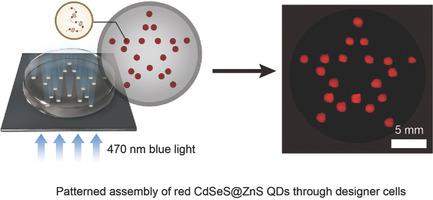当前位置:
X-MOL 学术
›
Adv. Mater.
›
论文详情
Our official English website, www.x-mol.net, welcomes your
feedback! (Note: you will need to create a separate account there.)
Programming Cells for Dynamic Assembly of Inorganic Nano‐Objects with Spatiotemporal Control
Advanced Materials ( IF 27.4 ) Pub Date : 2018-03-08 , DOI: 10.1002/adma.201705968 Xinyu Wang 1, 2, 3 , Jiahua Pu 1, 3, 4 , Bolin An 1, 3, 5 , Yingfeng Li 1, 2, 3 , Yuequn Shang 1, 2, 3 , Zhijun Ning 1 , Yi Liu 6 , Fang Ba 6 , Jiaming Zhang 1 , Chao Zhong 1
Advanced Materials ( IF 27.4 ) Pub Date : 2018-03-08 , DOI: 10.1002/adma.201705968 Xinyu Wang 1, 2, 3 , Jiahua Pu 1, 3, 4 , Bolin An 1, 3, 5 , Yingfeng Li 1, 2, 3 , Yuequn Shang 1, 2, 3 , Zhijun Ning 1 , Yi Liu 6 , Fang Ba 6 , Jiaming Zhang 1 , Chao Zhong 1
Affiliation

|
Programming living cells to organize inorganic nano‐objects (NOs) in a spatiotemporally precise fashion would advance new techniques for creating ordered ensembles of NOs and new bio–abiotic hybrid materials with emerging functionalities. Bacterial cells often grow in cellular communities called biofilms. Here, a strategy is reported for programming dynamic biofilm formation for the synchronized assembly of discrete NOs or hetero‐nanostructures on diverse interfaces in a dynamic, scalable, and hierarchical fashion. By engineering Escherichia coli to sense blue light and respond by producing biofilm curli fibers, biofilm formation is spatially controlled and the patterned NOs' assembly is simultaneously achieved. Diverse and complex fluorescent quantum dot patterns with a minimum patterning resolution of 100 µm are demonstrated. By temporally controlling the sequential addition of NOs into the culture, multilayered heterostructured thin films are fabricated through autonomous layer‐by‐layer assembly. It is demonstrated that biologically dynamic self‐assembly can be used to advance a new repertoire of nanotechnologies and materials with increasing complexity that would be otherwise challenging to produce.
中文翻译:

具有时空控制的无机纳米物体动态组装程序单元
对活细胞进行编程,使其以时空精确的方式组织无机纳米物体(NOs),将推动创建NOs有序集合的新技术和具有新兴功能的新型生物非生物杂化材料的发展。细菌细胞通常在称为生物膜的细胞群落中生长。此处报道了一种用于动态生物膜形成的编程策略,用于以动态,可扩展和分层的方式在不同的界面上同步组装离散NO或异质纳米结构。通过工程大肠杆菌为了感知蓝光并通过产生生物膜卷曲纤维来响应,生物膜的形成在空间上受到控制,并且同时实现了图案化的NO的组装。演示了最小图案分辨率为100 µm的多样且复杂的荧光量子点图案。通过暂时控制向培养物中NO的顺序添加,通过自主的逐层组装来制造多层异质结构薄膜。事实证明,生物动态自组装可用于推进纳米技术和材料的新应用,从而增加复杂性,否则将难以生产。
更新日期:2018-03-08
中文翻译:

具有时空控制的无机纳米物体动态组装程序单元
对活细胞进行编程,使其以时空精确的方式组织无机纳米物体(NOs),将推动创建NOs有序集合的新技术和具有新兴功能的新型生物非生物杂化材料的发展。细菌细胞通常在称为生物膜的细胞群落中生长。此处报道了一种用于动态生物膜形成的编程策略,用于以动态,可扩展和分层的方式在不同的界面上同步组装离散NO或异质纳米结构。通过工程大肠杆菌为了感知蓝光并通过产生生物膜卷曲纤维来响应,生物膜的形成在空间上受到控制,并且同时实现了图案化的NO的组装。演示了最小图案分辨率为100 µm的多样且复杂的荧光量子点图案。通过暂时控制向培养物中NO的顺序添加,通过自主的逐层组装来制造多层异质结构薄膜。事实证明,生物动态自组装可用于推进纳米技术和材料的新应用,从而增加复杂性,否则将难以生产。









































 京公网安备 11010802027423号
京公网安备 11010802027423号